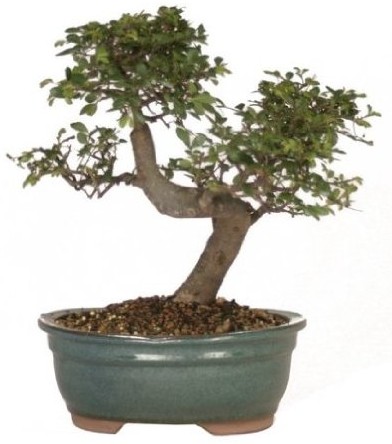 A native of China, Taiwan, Japan, and Korea, this deciduous tree is one of the best species of elm for bonsai. The leathery, dark green leaves attach to the stem without petioles and are very small as suggested by the specific name, parvifolia. The trunk is dark-gray and depending on the variety may be smooth or develop slight furrows or thick corky bark as it ages. Specimens with smooth bark tend to be less hardy The delicate twigs of the tree make it especially good for the broom style of bonsai while the long, thick, flexible roots make it suitable for clasped-to-rock style. Chinese elm, however, is suitable for training into every style of bonsai, and for growing in all sizes. In warm climates such as California, the tree does not drop its leaves and is evergreen. In Taiwan and China the plant has been cultivated for hundreds of years and is considered a very undemanding tree because it tolerates such problems as overwatering, underwatering, and changes in temperature. Experts agree that Chinese elm is a very good choice for a beginner.
A native of China, Taiwan, Japan, and Korea, this deciduous tree is one of the best species of elm for bonsai. The leathery, dark green leaves attach to the stem without petioles and are very small as suggested by the specific name, parvifolia. The trunk is dark-gray and depending on the variety may be smooth or develop slight furrows or thick corky bark as it ages. Specimens with smooth bark tend to be less hardy The delicate twigs of the tree make it especially good for the broom style of bonsai while the long, thick, flexible roots make it suitable for clasped-to-rock style. Chinese elm, however, is suitable for training into every style of bonsai, and for growing in all sizes. In warm climates such as California, the tree does not drop its leaves and is evergreen. In Taiwan and China the plant has been cultivated for hundreds of years and is considered a very undemanding tree because it tolerates such problems as overwatering, underwatering, and changes in temperature. Experts agree that Chinese elm is a very good choice for a beginner.
 Position: Where winters are warm, plants can be grown out doors in a bright sunny spot all year, taking care to avoid frost. In very hot areas, some shade is appreciated. In cooler climates it can be placed out doors from spring to autumn, but must slowly be acclimated to full sunlight. Where frost and cold temperatures exist, plants should be placed in a cool room with temperatures ranging from 42-71 F. In warmer temperatures it will need more light and good air circulation.
Position: Where winters are warm, plants can be grown out doors in a bright sunny spot all year, taking care to avoid frost. In very hot areas, some shade is appreciated. In cooler climates it can be placed out doors from spring to autumn, but must slowly be acclimated to full sunlight. Where frost and cold temperatures exist, plants should be placed in a cool room with temperatures ranging from 42-71 F. In warmer temperatures it will need more light and good air circulation.
 Water: Using tap water, when soil surface has dried out. Plants will need less water in winter.
Water: Using tap water, when soil surface has dried out. Plants will need less water in winter.
 Fertilizer: Use an organic or inorganic fertilizer every two weeks from early spring to mid-autumn; In winter, if the plant is kept in a cool place, feed once a month.
Fertilizer: Use an organic or inorganic fertilizer every two weeks from early spring to mid-autumn; In winter, if the plant is kept in a cool place, feed once a month.
 Repotting: Repot every 1-3 years in early spring, root pruning at the same time.
Repotting: Repot every 1-3 years in early spring, root pruning at the same time.
 Soil: Use bonsai soil or a mixture of loam, peat moss, and sand at a ratio of 2:1:1
Soil: Use bonsai soil or a mixture of loam, peat moss, and sand at a ratio of 2:1:1
 Pruning: Cut back new shoots of young plants to 2-3 leaves after 8-12 leaves have been produced.
Pruning: Cut back new shoots of young plants to 2-3 leaves after 8-12 leaves have been produced.
 Wiring: Wire one or two year old branches.
Wiring: Wire one or two year old branches.
 Propagation: Soft or hardwood cuttings in summer; root cuttings in winter
Propagation: Soft or hardwood cuttings in summer; root cuttings in winter
 Comments: Susceptible to spider mite infestation especially if winter conditions are too warm and dry. Avoid using systemic pesticides because they may cause defoliation with a consequent loss of vigor and die-back.
Comments: Susceptible to spider mite infestation especially if winter conditions are too warm and dry. Avoid using systemic pesticides because they may cause defoliation with a consequent loss of vigor and die-back.
To buy Chinese elm bonsai from Amazon.com click here.
